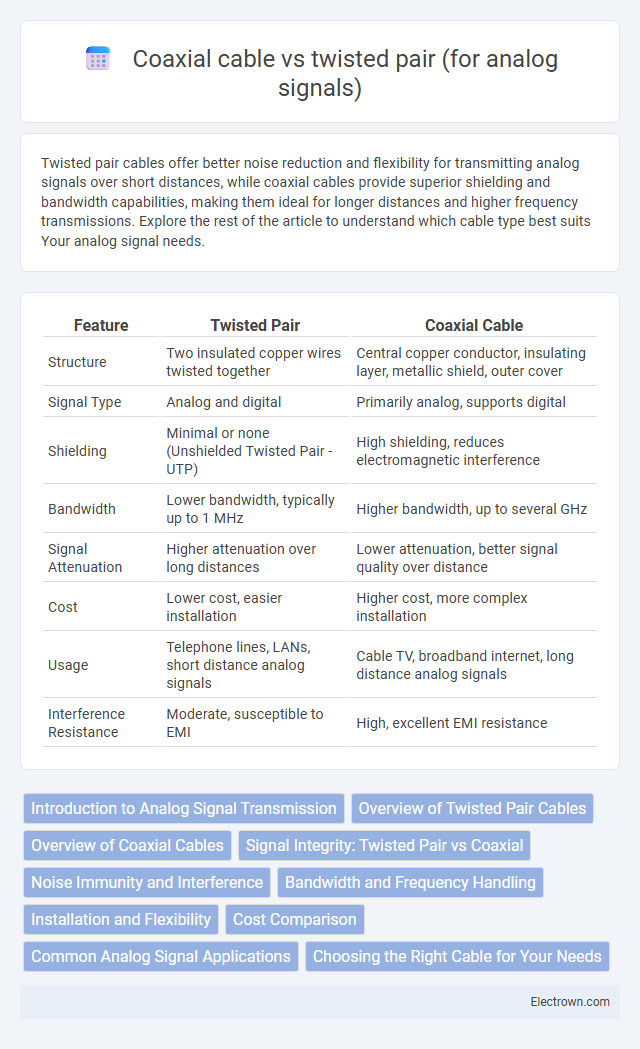Twisted pair cables offer better noise reduction and flexibility for transmitting analog signals over short distances, while coaxial cables provide superior shielding and bandwidth capabilities, making them ideal for longer distances and higher frequency transmissions. Explore the rest of the article to understand which cable type best suits Your analog signal needs.
Table of Comparison
| Feature | Twisted Pair | Coaxial Cable |
|---|---|---|
| Structure | Two insulated copper wires twisted together | Central copper conductor, insulating layer, metallic shield, outer cover |
| Signal Type | Analog and digital | Primarily analog, supports digital |
| Shielding | Minimal or none (Unshielded Twisted Pair - UTP) | High shielding, reduces electromagnetic interference |
| Bandwidth | Lower bandwidth, typically up to 1 MHz | Higher bandwidth, up to several GHz |
| Signal Attenuation | Higher attenuation over long distances | Lower attenuation, better signal quality over distance |
| Cost | Lower cost, easier installation | Higher cost, more complex installation |
| Usage | Telephone lines, LANs, short distance analog signals | Cable TV, broadband internet, long distance analog signals |
| Interference Resistance | Moderate, susceptible to EMI | High, excellent EMI resistance |
Introduction to Analog Signal Transmission
Twisted pair and coaxial cables serve as key mediums for analog signal transmission, each offering distinct advantages in noise reduction and signal integrity. Twisted pair cables excel in minimizing electromagnetic interference through their paired wire design, making them suitable for short to medium distances. Coaxial cables, with a central conductor surrounded by insulation and shielding, provide superior protection against external noise and can transmit analog signals over longer distances with less attenuation.
Overview of Twisted Pair Cables
Twisted pair cables consist of two insulated copper wires twisted together to reduce electromagnetic interference, making them ideal for analog signal transmission over short distances. Their balanced design minimizes crosstalk and noise, improving signal integrity compared to coaxial cables in certain environments. Due to lower cost and flexibility, twisted pair cables are commonly used in telephone lines and older analog video applications.
Overview of Coaxial Cables
Coaxial cables consist of a central conductor, insulating layer, metallic shield, and protective outer jacket, designed to minimize electromagnetic interference and signal loss in analog transmissions. Their structure provides superior bandwidth and durability compared to twisted pair cables, making them ideal for high-frequency analog signals such as cable television and broadband Internet. Your choice of coaxial cable ensures reliable analog signal quality over longer distances with reduced noise.
Signal Integrity: Twisted Pair vs Coaxial
Twisted pair cables offer good noise rejection through differential signaling, making them suitable for analog signals in environments with moderate electromagnetic interference. Coaxial cables provide superior shielding with a solid metallic outer conductor, resulting in higher signal integrity and less signal attenuation over longer distances. For analog signal transmission, coaxial cables generally maintain better signal quality compared to twisted pair cables, especially where electromagnetic noise is prevalent.
Noise Immunity and Interference
Twisted pair cables exhibit superior noise immunity for analog signals due to their balanced design and differential signaling, effectively canceling out electromagnetic interference (EMI) and crosstalk. Coaxial cables provide excellent shielding through a conductive outer layer, significantly reducing susceptibility to external EMI and maintaining signal integrity over longer distances. However, twisted pair cables are more vulnerable to electromagnetic noise without proper shielding, while coaxial cables offer enhanced protection against high-frequency interference in analog signal transmission.
Bandwidth and Frequency Handling
Twisted pair cables typically support bandwidths up to 100 MHz, making them suitable for lower-frequency analog signal transmission, while coaxial cables handle much higher frequencies, often exceeding 1 GHz, providing superior bandwidth for analog signals. Coaxial cables' shielded design reduces electromagnetic interference, enhancing signal integrity over longer distances compared to twisted pair. For your analog signal needs requiring higher frequency handling and bandwidth, coaxial cable is the preferred choice.
Installation and Flexibility
Twisted pair cables offer easier installation and greater flexibility due to their lightweight, thin structure, allowing them to be routed through tight spaces and complex pathways. Coaxial cables, while providing better shielding for analog signals, are thicker and more rigid, making installation more challenging and less adaptable to dynamic layouts. Twisted pair is preferred in environments requiring frequent adjustments or complex wiring runs, whereas coaxial is chosen for stable, fixed installations demanding superior interference resistance.
Cost Comparison
Twisted pair cables generally offer a lower cost compared to coaxial cables, making them a budget-friendly option for analog signal transmission in short to moderate distances. Coaxial cables, while more expensive, provide better shielding against electromagnetic interference, which can reduce signal degradation over longer distances. The cost difference often reflects the enhanced durability and performance of coaxial cables, but twisted pair remains a popular choice where budget constraints and installation simplicity are priorities.
Common Analog Signal Applications
Twisted pair cables are commonly used for analog telephone lines and audio transmission due to their resistance to electromagnetic interference and cost-effectiveness. Coaxial cables dominate analog video applications such as cable TV and CCTV systems because of their superior shielding and higher bandwidth capacity. Choosing the right cable for your analog signal applications depends on the required signal quality and environmental noise conditions.
Choosing the Right Cable for Your Needs
Twisted pair cables offer excellent noise rejection and are cost-effective for short-distance analog signal transmission, making them ideal for telephone lines and simple audio setups. Coaxial cables provide superior shielding and higher bandwidth capacity, which are essential for maintaining signal quality over longer distances or in environments with significant electromagnetic interference. Your choice should depend on the specific application requirements, balancing factors like signal integrity, distance, and budget constraints.
Twisted pair vs coaxial cable (for analog signals) Infographic

 electrown.com
electrown.com